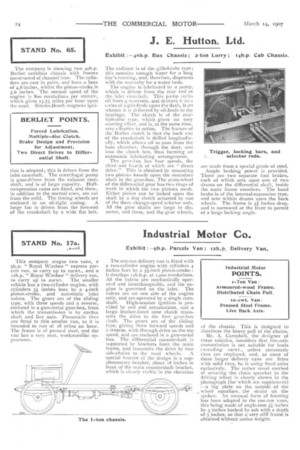Industrial Motor Co.
Page 24

If you've noticed an error in this article please click here to report it so we can fix it.
This company stages two vans, a 9h.p. " Royal Windsor " express parcels van, to carry up to locwt., and a 12h.p. " Royal Windsor "delivery van,
to carry up to zocwt. The smaller vehicle has a two-cylinder engine, with cylinders 3i inches bore by a 4-inch piston-stroke, and automatic inlet valves. The gears are of the sliding type, with three speeds and a reverse, enclosed in a gun-metal gear-box, from which the transmission is by cardan shaft and live axle. Pneumatic tires are fitted to this smaller van, as it is intended to run at 18 miles an hour. The frame is of pressed steel, and the van has a very neat, workmanlike appearance.
The one-ton delivery van is fitted with a two-cylinder engine with cylinders 4 inches bore by a 5L-inch piston-stroke : it develops 12b.h.p. at 1,000 revolutions. All the valves are mechanically oper.ated and interchangeable, and the engine is governed on the inlet. The valves are on one side of the engine only, and are operated by a single cam
shaft. High-tension ignition is provided by coil and accumulator, and a large leather-faced cone clutch transmits the drive. to the first gear-box :±aft. The gears are of the sliding type, giving three forward speeds and a reverse, with through drive on the top speed, and are enclosed in a gun-metal box. The differential countershaft is supported by brackets from the main frame, and transmits the drive by two side-chains to the road wheels. A special feature of the design is a supplementary bracket, about 18 inches in front of the main countershaft bracket, which is clearly visible in the elevation
of the chassis. This is designed to distribute the heavy pull of the chains.
Mr. A. Campbell, the designer of these vehicles, considers that live-axle transmission is not suitable for loads exceeding i °cwt., unless pneumatic tires are employed, and, as most of these larger delivery vans are fitted with solid tires, he is using fixed axles exclusively. The rather novel method of securing the chain sprocket to the driving wheel is clearly shown in the photograph (for which see supplement) —a big plate on the outside of the wheel . equalises._ the strain on the spokes. An unusual form of framing has been adopted in the one-ton vans,
this 'being made of angle-iron inches by 3 inches backed by ash with a depth of 3 inches, so that a very stiff frame is obtained without undue weight.
































































